Manual Fiber Polarization Controllers

- Polarization Over Full Poincaré Sphere
- Controllers Available Preloaded with 1 of 6 Fibers
- Empty Controllers for Ø900 µm Jacketed Fiber
- FC/PC or FC/APC Connectors
FPC030
Empty Controller with Ø1.06" Loops
FPC024
Preloaded with HI1060 Fiber, FC/APC
FPC031
Preloaded with ClearCurve® Fiber, FC/PC
FPC560
Empty Controller with Ø2.2" Loops
FPC020
Empty Controller with Ø0.71" Loops

Please Wait
The animation above shows an ideal case. The fractional retardance of each paddle depends upon many factors, including the wavelength, the number of fiber loops, and the fiber type. For more details, please see the Operation tab.
Features
- Convert Between Linear, Circular, and Elliptical Polarization States
- Operates over Full Fiber Bandwidth
- Empty Controllers for Ø900 µm Jacketed FC/PC or FC/APC Patch Cables
- Preloaded Controllers with FC/PC- or FC/APC-Terminated Fibers (2.0 mm Narrow Key)
- Three Loop Diameters Available
- Three-Paddle Controllers: Ø1.06" or Ø2.2"
- Two-Paddle Controllers: Ø0.71"
Thorlabs' Fiber Polarization Controllers use stress-induced birefringence produced by wrapping the fiber around two or three spools to create independent wave plates that will alter the polarization of the transmitted light in a single mode fiber. The fast axis of the fiber is in the plane of the spool, allowing an arbitrary input polarization state to be adjusted by rotating the paddles. See the animation to the right and the Operation tab for more details.
The controllers are available in a 3-paddle configuration with either 1.06" or 2.2" diameter loops as well as a mini 2-paddle configuration with 0.71" diameter loops. Thorlabs offers an empty controller in each style to allow the user to insert single mode fiber with a Ø900 µm jacket, such as a bare fiber, FC/PC patch cable, or FC/APC patch cable. To ensure proper usage of the controllers, fiber cables must be long enough to achieve the recommended number of loops; see the Operation tab for more details. For fibers with higher bend loss, we recommend using the version with the largest spools (FPC560), thereby causing the least amount of bending. Controllers are also available preloaded with one of six fiber types, although the preloaded fiber may be replaced with another fiber should a different wavelength range be required for future applications. See the Specs tab for the available configurations.
We also offer In-Line Polarization Controllers. These controllers create a single continously variable wave plate similar to a Soleil-Babinet compensator, enabling polarization control over the full Poincaré sphere.
| Fiber Polarization Control Selection Guide | ||||||
|---|---|---|---|---|---|---|
| Polarization Controllers | Linear Polarizers | |||||
 |
 |
 |
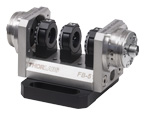 |
 |
 |
 |
| Motorized Fiber Polarization Controllers | Manual Paddle Fiber Polarization Controllers | In-Line Manual Fiber Polarization Controller | Free-Space FiberBench | Faraday Mirrors | In-Line Fiber Polarizers | Polarizing Fiber |
3-Paddle Polarization Controllers, Ø56 mm Loop
| Item # | FPC560 | FPC563 | FPC564 | FPC561 | FPC562 |
|---|---|---|---|---|---|
| Number of Paddles | 3 | ||||
| Loop Diameter | 2.2" (56 mm) | ||||
| Paddle Rotation | ±117.5° | ||||
| Footprint (L x W) | 12.50" x 1.00" (317.5 mm x 25.4 mm) in Narrowest Configuration 12.50" x 4.85" (317.5 mm x 123.2 mm) in Widest Configuration |
||||
| Specifications for Preloaded Fiber (As Shipped by Thorlabs) | |||||
| Fiber | None | 780HP | HI1060-J9 | SMF-28-J9 | |
| Included Patch Cable | None | P3-780Y-FC-5 | P3-1064Y-FC-5 | P1-SMF28Y-FC-5 | P3-SMF28Y-FC-5 |
| Operating Wavelength Rangea | N/A | 780 - 970 nm | 980 - 1650 nm | 1260 - 1625 nm | |
| Design Wavelengthb | N/A | 780 nm and 850 nm | 980 nm and 1064 nm | 1310 nm and 1550 nm | |
| Mode Field Diameter | N/A | 5.0 ± 0.5 µm @ 850 nm | 5.9 ± 0.3 µm @ 980 nm 6.2 ± 0.3 µm @ 1060 nm |
9.2 ± 0.4 µm @ 1310 nm 10.4 ± 0.5 µm @ 1550 nm |
|
| Cladding Diameter | N/A | 125 ± 1 µm | 125 ± 0.5 µm | 125 ± 0.7 µm | |
| Coating Diameter | N/A | 245 ± 15 µm | 245 ±10 µm | 242 ± 5 µm | |
| Cutoff Wavelength | N/A | 730 ± 30 nm | 920 ± 50 | <1260 nm | |
| NA | N/A | 0.13 | 0.14 | 0.14 | 0.14 |
| Jacketing | N/A | Ø900 µm Hytrel®c Tubing | Ø900 µm Tight Buffer | ||
| Loop Configuration | N/A | 2 Loops - 4 Loops - 2 Loops | 3 Loops - 6 Loops - 3 Loops | ||
| Total Fiber Lengthd | N/A | 5 m +7/-0 cm | 5 m | ||
| Fiber Lead Lengthe | N/A | 180 cm | 145 cm | ||
| Connectorsf | N/A | FC/APC | FC/PC | FC/APC | |
| Bend Loss | N/A | ≤0.1 dB | |||
3-Paddle Polarization Controllers, Ø27 mm Loop
| Item # | FPC030 | FPC033 | FPC034 | FPC031 | FPC032 |
|---|---|---|---|---|---|
| Number of Paddles | 3 | ||||
| Loop Diameter | 1.06" (27 mm) | ||||
| Paddle Rotation | ±117.5° | ||||
| Footprint (L x W) | 8.50" x 1.00" (215.9 mm x 25.4 mm) in Narrowest Configuration 8.50" x 2.51" (215.9 mm x 63.8 mm) in Widest Configuration |
||||
| Specifications for Preloaded Fiber (As Shipped by Thorlabs) | |||||
| Fiber | None | 780HP | HI1060-J9 | CCC1310-J9 | |
| Included Patch Cable | None | P3-780Y-FC-2 | P3-1064Y-FC-2 | -b | |
| Operating Wavelength Rangea | N/A | 780 - 970 nm | 980 - 1650 nm | 1260 - 1625 nm | |
| Design Wavelengthc | N/A | 780 nm and 850 nm | 980 nm and 1064 nm | 1310 nm and 1550 nm | |
| Mode Field Diameter | N/A | 5.0 ± 0.5 µm @ 850 nm | 5.9 ± 0.3 µm @ 980 nm 6.2 ± 0.3 µm @ 1060 nm |
8.6 ± 0.4 µm @ 1310 nm 9.7 ± 0.5 µm @ 1550 nm |
|
| Cladding Diameter | N/A | 125 ± 1 µm | 125 ± 0.5 µm | 125 ± 0.7 µm | |
| Coating Diameter | N/A | 245 ± 15 µm | 245 ± 10 µm | 242 ± 5 µm | |
| Cutoff Wavelength | N/A | 730 ± 30 nm | 920 ± 50 nm | ≤1260 nm | |
| NA | N/A | 0.13 | 0.14 | 0.14 | 0.14 |
| Jacketing | N/A | Ø900 µm Hytrel®d Tubing | Ø900 µm Tight Buffer | ||
| Loop Configuration | N/A | 1 Loop - 2 Loops - 1 Loop | 3 Loops - 2 Loops - 3 Loops | 4 Loops - 3 Loops - 4 Loops | |
| Total Fiber Lengthe | N/A | 2 m +7/-0 cm | 2 m | ||
| Fiber Lead Lengthf | N/A | 83 cm | 66 cm | 70 cm | |
| Connectorsg | N/A | FC/APC | FC/PC | FC/APC | |
| Bend Loss | N/A | ≤0.1 dB | |||
2-Paddle Fiber Polarization Controllers, Ø18 mm Loop
| Item # | FPC020 | FPC021 | FPC022 | FPC023 | FPC024 | FPC025 |
|---|---|---|---|---|---|---|
| Number of Paddles | 2 | |||||
| Loop Diameter | 0.71" (18 mm) | |||||
| Paddle Rotation | ±143° | |||||
| Foot Print (L x W) | 3.06" x 0.50" (77.6 mm x 12.7 mm) in Narrowest Configuration 3.06" x 1.75" (77.6 mm x 44.5 mm) in Widest Configuration |
|||||
| Specifications for Preloaded Fiber (As Shipped by Thorlabs) | ||||||
| Fiber | None | SM450 | SM600 | 780HP | HI1060-J9 | CCC1310-J9 |
| Included Patch Cable | None | P3-460Y-FC-2 | P3-630Y-FC-2 | P3-780Y-FC-2 | P3-1064Y-FC-2 | -b |
| Operating Wavelength Rangea | N/A | 488 - 633 nm | 633 - 780 nm | 780 - 970 nm | 980 - 1650 nm | 1260 - 1625 nm |
| Design Wavelengthc | N/A | 488 nm | 633 nm | 780 nm and 850 nm | 980 nm and 1064 nm | 1310 nm and 1550 nm |
| Mode Field Diameter | N/A | 2.8 - 4.1 µm @ 488 nm | 3.6 - 5.3 µm @ 633 nm | 5.0 ± 0.5 µm @ 850 nm | 5.9 ± 0.3 µm @ 980 nm 6.2 ± 0.3 µm @ 1060 nm |
8.6 ± 0.4 µm @ 1310 nm 9.7 ± 0.5 µm @ 1550 nm |
| Cladding Diameter | N/A | 125 ± 1.0 µm | 125 ± 1.0 µm | 125 ± 1.5 µm | 125 ± 0.5 µm | 125 ± 0.7 µm |
| Coating Diameter | N/A | 245 ± 15 µm | 245 ± 15 µm | 245 ± 15 µm | 245 ± 10 µm | 242 ± 5 µm |
| Cutoff Wavelength | N/A | 350 - 470 nm | 550 ± 50 nm | 730 ± 30 nm | 920 ± 50 nm | ≤1260 nm |
| NA | N/A | 0.10 - 0.14 | 0.10 - 0.14 | 0.13 | 0.14 | 0.14 |
| Jacketing | N/A | Ø900 µm Hytrel®d Tubing | Ø900 µm Tight Buffer | |||
| Loop Configuration | N/A | 3 Loops - 2 Loops | 3 Loops - 1 Loop | 4 Loops - 1 Loop | 2 Loops - 4 Loops | 1 Loop - 2 Loops |
| Total Fiber Lengthe | N/A | 2 m +7/-0 cm | ||||
| Fiber Lead Lengthf | N/A | 83 cm | 85 cm | 88 cm | 80 cm | 83 cm |
| Connectorsg | N/A | FC/APC | ||||
| Bend Loss | N/A | ≤0.1 dB | ||||
These manual polarization controllers utilize stress-induced birefringence to create two or three independent fractional wave plates to alter the polarization in single mode fiber that is looped around two or three independent spools to create the independent fractional wave plates (fiber retarders). The amount of birefringence induced in the fiber is a function of the fiber cladding diameter, the spool diameter (fixed), the number of fiber loops per spool, and the wavelength of the light. (NOTE: The desired birefringence is induced by the loop in the fiber, not by the twisting of the fiber paddles). The fast axis of the fiber, which is in the plane of the spool, is adjusted with respect to the transmitted polarization vector by manually rotating the paddles to twist the fiber. To transform an arbitrary input polarization state into another arbitrary output polarization state, a combination of three paddles (a quarter-wave plate, a half-wave plate, and a quarter-wave plate) or two paddles (quarter-wave plate and a half-wave plate) can be used. Because a three-paddle configuration decouples the two quarter-wave plates, more polarization states can be achieved compared to a two-paddle configuration. The retardance of each paddle may be estimated from the following equation:
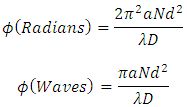
Here, φ is the retardance, a is a constant (0.133 for silica fiber), N is the number of loops, d is the fiber cladding diameter, λ is the wavelength, and D is the loop diameter. While this equation is for bare fiber, the solution for Ø900 µm jacketed fiber will be similar enough that the results for this equation can still be used (i.e., the solution will not vary by a complete loop N for Ø900 µm jacketed fiber).
Recommended Number of Loops
The recommended number of loops, fiber, and patch cables for several wavelengths is given in the following tables. These combinations come close to the desired quarter-wave retardation:
| Wavelength | # of Loops for ~1/4λ Retardation | Recommended Fiber | Recommended Patch Cables |
||
|---|---|---|---|---|---|
| Ø18 mm | Ø27 mm | Ø56 mm | |||
| 480 nm | 3 Loops | N/A | 3 Loops | 460HP or SM450 | P1-460Y-FC-2, P3-460Y-FC-2 |
| 630 nm | 3 Loops | 2 Loops | 4 Loops | 630HP or S630-HP | P1-630Y-FC-2, P3-630Y-FC-2 |
| 780 nm | 4 Loops | 1 Loop | 2 Loops | 780HP, S630-HP, or SM600 | P1-780Y-FC-2 P3-780Y-FC-2 P3-780Y-FC-5 |
| 850 nm | 3 Loops | 1 Loop | 2 Loops | 780HP or SM800-5.6-125 | P1-780Y-FC-2, P3-780Y-FC-2, P3-780Y-FC-5 |
| 980 nm | 2 Loops | 3 Loops | 2 Loops | 980HP, HI1060-J9, or 1060XP | P1-1064Y-FC-2, P3-1064Y-FC-2, P3-1064Y-FC-5 |
| 1060 nm | 2 Loops | 3 Loops | 2 Loops | 980HP, HI1060-J9, or 1060XP | P1-1064Y-FC-2, P3-1064Y-FC-2, P3-1064Y-FC-5 |
| 1310 nm | 1 Loop | 4 Loops | 3 Loops | SMF-28-J9 or CCC1310-J9 | P1-SMF28Y-FC-2, P1-SMF28Y-FC-5 ,P3-SMF28Y-FC-2, P3-SMF28Y-FC-5 |
| 1550 nm | 1 Loop | 2 Loops | 3 Loops | SMF-28-J9 or CCC1310-J9 | P1-SMF28Y-FC-2 P1-SMF28Y-FC-5 P3-SMF28Y-FC-2 P3-SMF28Y-FC-5 |
These combinations come close to the desired half-wave retardation:
| Wavelength | # of Loops for ~1/2λ Retardation | Recommended Fiber | Recommended Patch Cables |
||
|---|---|---|---|---|---|
| Ø18 mm | Ø27 mm | Ø56 mm | |||
| 480 nm | 2 Loops | 3 Loops | 2 Loops | 460HP or SM450 | P1-460Y-FC-2, P3-460Y-FC-2 |
| 630 nm | 1 Loop | 4 Loops | 3 Loops | 630HP or S630-HP | P1-630Y-FC-2, P3-630Y-FC-2 |
| 780 nm | 1 Loop | 2 Loops | 4 Loops | 780HP, S630-HP, or SM600 | P1-780Y-FC-2 P3-780Y-FC-2 P3-780Y-FC-5 |
| 850 nm | 1 Loop | 2 Loops | 4 Loops | 780HP or SM800-5.6-125 | P1-780Y-FC-2, P3-780Y-FC-2, P3-780Y-FC-5 |
| 980 nm | 4 Loops | 2 Loops | 4 Loops | 980HP, HI1060-J9, or 1060XP | P1-1064Y-FC-2, P3-1064Y-FC-2, P3-1064Y-FC-5 |
| 1060 nm | 4 Loops | 2 Loops | 4 Loops | 980HP, HI1060-J9, or 1060XP | P1-1064Y-FC-2, P3-1064Y-FC-2, P3-1064Y-FC-5 |
| 1310 nm | 2 Loops | 3 Loops | 6 Loops | SMF-28-J9 or CCC1310-J9 | P1-SMF28Y-FC-2, P1-SMF28Y-FC-5, P3-SMF28Y-FC-2, P3-SMF28Y-FC-5 |
| 1550 nm | 2 Loops | 3 Loops | 6 Loops | SMF-28-J9 or CCC1310-J9 | P1-SMF28Y-FC-2 P1-SMF28Y-FC-5 P3-SMF28Y-FC-2 P3-SMF28Y-FC-5 |
Three-Paddle Polarization Controllers
A three-paddle polarization controller combines a quarter-wave plate, half-wave plate, and quarter-wave plate in series to transform an arbitrary polarization state into another polarization state. The first quarter-wave plate would transform the input polarization state into a linear polarization state. The half-wave plate would rotate the linear polarization state, and the last quarter-wave plate would transform the linear state into an arbitrary polarization state. This is illustrated in the animation on the Overview tab. Therefore, adjusting each of the three paddles (fiber retarders) allows complete control of the output polarization state over a broad range of wavelengths from 500 to 1600 nm). Using FPC030 as an example, a plot of calculated retardation per paddle versus wavelength is shown in Figure 1 for a fiber with a cladding diameter of 125 μm. For fiber with a cladding diameter of 80 μm, the retardation per paddle versus wavelength is shown in Figure 2. The FPC030 has a loop diameter of 27 mm.

Click to Enlarge
Figure 1: Plot of the retardance per paddle for silica fiber with Ø125 µm cladding on the FPC030, which has a loop diameter of 27 mm.
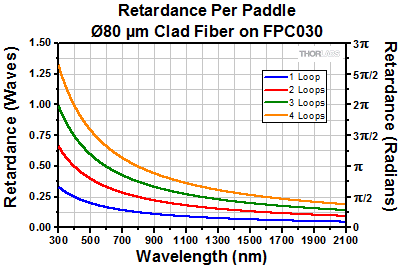
Click to Enlarge
Figure 2: Plot of the retardance per paddle for silica fiber with Ø80 µm cladding on the FPC030, which has a loop diameter of 27 mm.
Figures 3 and 4 show the results for Ø125 µm and Ø80 µm clad fiber, respectively, for the FPC560 controller, which has three paddles with a loop diameter of 56 mm. The larger loop diameter is ideal for fibers with higher bend loss.
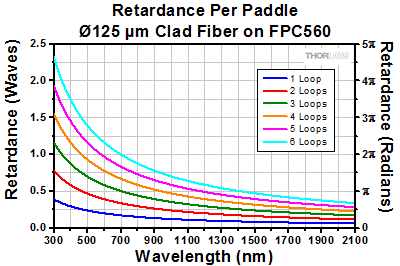
Click to Enlarge
Figure 3: Plot of the retardance per paddle for silica fiber with Ø125 µm cladding on the FPC560, which has a loop diameter of 56 mm.
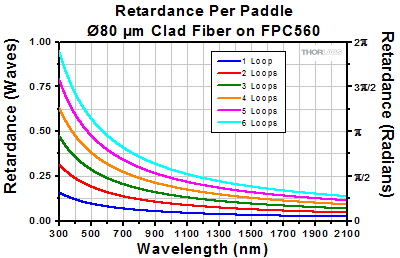
Click to Enlarge
Figure 4: Plot of the retardance per paddle for silica fiber with Ø80 µm cladding on the FPC560, which has a loop diameter of 56 mm.
Miniature Two-Paddle Polarization Controller
The miniature two-paddle polarization controllers use a quarter-wave plate and a half-wave plate to transform an arbitrary polarization state into another polarization state. In the two-paddle configuration, however, the control of the polarization will be coupled between the two paddles and therefore it may be difficult to achieve a specific polarization state. The design of the FPC020 allows complete control of the output polarization state over a broad range of wavelengths. Figures 5 and 6 show the calculated retardation per paddle for Ø125 µm and Ø80 µm clad bare fiber, respectively, for the FPC020, which has a loop diameter of 18 mm.
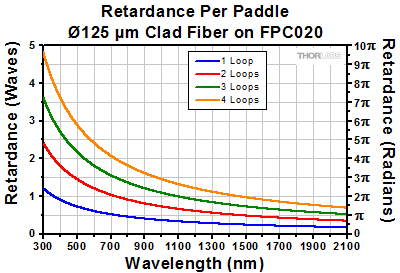
Click to Enlarge
Figure 5: Plot of the retardance per paddle for bare silica fiber with Ø125 µm cladding on the FPC020, which has a loop diameter of 18 mm.
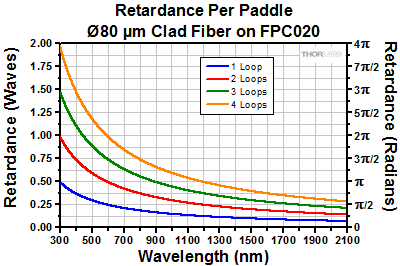
Click to Enlarge
Figure 6: Plot of the retardance per paddle for bare silica fiber with Ø80 µm cladding on the FPC020, which has a loop diameter of 18 mm.
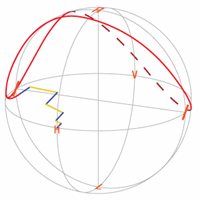
Click for Details
Figure 2: Poincaré sphere showing the polarization rotation from a three paddle polarization controller.
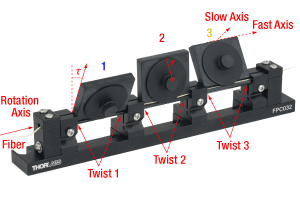
Click to Enlarge
Figure 1: Forces produced by the fiber controller paddle
Thorlabs Lab Facts: Using Fiber Paddles to Manipulate Polarization
We present laboratory measurements of the influence on the output polarization state from a fiber due to rotation and twist forces from the fiber polarization controller (FPC). This controller utilizes the effects of stress-induced birefringence to create changes in the polarization of light traveling through a fiber under stress. The stress can be caused either through twisting or rotating [1], as shown in Figure 1. It was found that by using the appropriate number of loops on each paddle that the stress-induced birefringence can be adjusted continuously. This then allows for any arbitrary input polarization state to be rotated into any desired output polarization state. We detail the procedures necessary to achieve a desired output polarization, and plot the change in the polarization on a Poincaré sphere to illustrate the steps necessary in reaching a desired polarization state.
For our experiment, we used the previous-generation S1FC1310 Fabry-Perot Benchtop Laser (1310 nm) as the light source and coupled it into a SMF-28-J9 Ø900 µm tight-buffer fiber. The fiber was mounted through a FPC030 Fiber Polarization Controller, and the output was collimated into a free-space beam with a F220FC-C fiber collimator. From here the beam was measured, either directly by a polarimeter or through an analyzer assembly consisting of a WPQ05M-1310 λ/4 wave plate, a LPNIR100 linear polarizer, and a PM100D power meter.
Figure 2 summarizes the measured results for manipulating the polarization of light in a fiber as a function of rotation and twist forces and is shown on the Poincaré sphere. The colored lines represent one of the three paddles of the FPC030 and correspond to the colored numbers of Figure 1. To produce quarter-wave plate behavior, the fiber needed to be looped around a paddle two times, and for half-wave plate behavior it was 3 times. For the results presented in Figure 2, we used the FPC030 FPC in a 2-3-2 loop configuration. As shown in Figure 2, starting at any arbitrary polarization state, it is possible to achieve any desired polarization state through rotating each paddle through a number of iterations. This manipulation of the polarization by the FPC does not produce intrinsic loss nor back reflections; instead stress-induced birefringence is utilized as a mechanism for rotating the polarization of light in fiber. Data is presented for each of the paddles of the FPC and the polarization changes due to these are mapped out on Poincaré spheres. For details on the experimental setup employed and the results obtained, please click here.
[1] R. Ulrich, A. Simon, “Polarization optics of twisted single-mode fibers” Appl. Opt. 18, 2241-2251 (1979).
Insights into Polarization Conventions
Scroll down to read about:
- Labels Used to Identify Perpendicular and Parallel Components
Click here for more insights into lab practices and equipment.
Labels Used to Identify Perpendicular and Parallel Components
When polarized light is incident on a surface, it is often described in terms of perpendicular and parallel components. These are orthogonal to each other and the direction in which the light is propagating (Figure 1).
Labels and symbols applied to the perpendicular and parallel components can make it difficult to determine which is which. The table identifies, for a variety of different sets, which label refers to the perpendicular component and which to the parallel.
| Labels | Notes |
|
|---|---|---|
| Perpendicular | Parallel | |
| s | p | Senkrecht (s) is 'perpendicular' in German. Parallel begins with 'p.' |
| TE | TM | TE: Transverse electric field. |
| ⊥ | // | ⊥ and // are symbols for perpendicular and parallel, respectively. |
| σ | π | The Greek letters corresponding to s and p are σ and π, respectively. |
| Sagittal | Tangential | A sagittal plane is a longitudinal plane that divides a body. |
The perpendicular and parallel directions are referenced to the plane of incidence, which is illustrated in Figure 1 for a beam reflecting from a surface. Together, the incident ray and the surface normal define the plane of incidence, and the incident and reflected rays are both contained in this plane. The perpendicular direction is normal to the plane of incidence, and the parallel direction is in the plane of incidence.
The electric fields of the perpendicular and parallel components oscillate in planes that are orthogonal to one another. The electric field of the perpendicular component oscillates in a plane perpendicular to the plane of incidence, while the electric field of the parallel component oscillated in the plane of incidence. The polarization of the light beam is the vector sum of the perpendicular and parallel components.
Normally Incident Light
Since a plane of incidence cannot be defined for normally incident light, this approach cannot be used to unambiguously define perpendicular and parallel components of light. There is limited need to make the distinction, since under conditions of normal incidence the reflectivity is the same for all components of light.
Date of Last Edit: Mar. 5, 2020
| Posted Comments: | |
M M
(posted 2024-06-28 10:19:48.48) Hello. Do you have the transmission profile (losses as a function of wavelength) of your FPC032?
When we measure the transmission of the FPC032 around 1310nm, we have noisy oscillations. The noise amplitude is around 0.2dB peak to peak and the pseudo-periode of the oscillations is around 0.7nm. We do not mind flat losses but this noise is very troublesome. We would like to understand if it comes from the FPC032 or from our transmission measurement setup.
Thanks a lot. cdolbashian
(posted 2024-07-01 04:40:22.0) Thank you for reaching out to us with this inquiry. These paddle polarization controllers are simply fiber wound around some mechanical paddles. The transmission will follow that of the fiber itself. In this case, the spec sheet for the fiber used in the FPC032 can be found here: www.thorlabs.com/_sd.cfm?fileName=TTN019023-S01.pdf&partNumber=CCC1310-J9. I have contacted you directly to troubleshoot your experimental problems related to the noise you are observing. Timm Landes
(posted 2024-06-18 08:49:27.26) Hi,
do you think you will design one Controller for 532 nm at some point? From your "Operation" tab, I would think that this requires just a different size of the loops or am I overlokking something?
Best
Timm cdolbashian
(posted 2024-06-21 04:23:14.0) Thank you for reaching out to us with this inquiry. You are correct that you simply need the appropriate fiber and configuration. I have reached out to you directly to make some suggestions and provide additional supporting documentation. user
(posted 2024-06-01 22:13:24.12) I am looking for paddles that can work with fibers that have 3mm jackets. Do you have such a product? I seem to recall using one in my old lab but do not remember the details. cdolbashian
(posted 2024-06-24 10:37:15.0) Thank you for reaching out to us with this inquiry. While this does not seem very different from what we already sell, it might be inherently unfeasible due to the way in which polarization is induced. When using a 3mm jacket, the jacket would be absorbing and cushioning the fiber from the intended stress, requiring much larger forces to generate the same stressed induced polarization effects. I have contacted you directly in order to gather a bit more information regarding your application. Perhaps we have an alternative solution for you. Kanad Sengupta
(posted 2024-05-13 12:50:21.453) Hi, we are using FPC033 - Fiber Polarization Controller, 3 Ø27 mm Paddles, 780HP, FC/APC Connectors. Is it possible to ensure that, regardless of the polarization input, the device will consistently produce the same output polarization when set to a fixed paddle orientation? cdolbashian
(posted 2024-05-24 10:22:40.0) Thank you for reaching out to us with this inquiry. The nature of the paddle controller is that it induces an anisotropy to the index of the fiber, which in-turn applies a phase shift to your orthogonal polarization vectors. As this is the case, your output polarization state is dependent on your input state, as well as the configuration of your paddle controller. I have contacted you directly to discuss this further. Manuel Monterrosas
(posted 2024-02-27 12:41:50.403) Are Fiber Polarization Controllers reciprocal, i.e., will the light traveling back in the fiber be reversed back to its original input state? cdolbashian
(posted 2024-03-11 01:49:33.0) Thank you for reaching out to us with this inquiry. Generally stress-induced anisotropy should be reversible by reversing the direction of the transmission. However, you must be careful when using mirrors, as reflection from a mirror will change the handed-ness of your elliptical state. As a result, transmission through some phase-delaying optics will yield unexpected results (or expected results if you have planned for it). I have contacted you directly to discuss this. Jose Mejia
(posted 2023-12-11 08:09:13.57) We are coupling single photons from an SPDC process in which one of the photons is H and the other is V. What is the best way to control the polarization of such SPDC photons? cdolbashian
(posted 2023-12-15 03:31:26.0) Thank you for reaching out to us with this inquiry. A typical way to achieve this is by implementing a waveplate. By using such an element, you affect the probability of transmission and will see a loss of single photon counts. In order to match the other channel, you can use a window on the other channel to compensate the loss to keep them in balanced. I have contacted you directly to discuss this further. Simon Neves
(posted 2023-02-18 17:01:54.75) Dear Sir/Madam,
Some time ago I purchased a few FPC032 in order to control the polarization of a pulsed EM field around 1550nm, with ~2ps pulse duration. After some time I realized the FPC032 tended to slightly depolarize the field, because of some dispersion occuring when bending the fiber. Actually, this effectively entangled the wavelength and polarization of the EM field.
Now I'm interested in femtosecond applications, around 1060nm, for which I'm even more worried about this potential depolarization occuring in fibers, as the EM spectrum is going to be far broader than the one I had previously. I imagine using a larger bending radius should mitigate the effect, such as in FPC564, but I would be interested in getting more information on that matter. Could you please provide me some information on the dispersion in such fibers, and how it evolves under bending?
Thank you jgreschler
(posted 2023-02-24 10:53:21.0) Thank you for reaching out to Thorlabs. Additional specs and data can be requested by contacting techsupport@thorlabs.com. I have reached out to you directly to discuss possible causes and solutions for this effect. jgreschler
(posted 2023-02-24 10:53:21.0) Thank you for reaching out to Thorlabs. Additional specs and data can be requested by contacting techsupport@thorlabs.com. I have reached out to you directly to discuss possible causes and solutions for this effect. Konstantin Khrizman
(posted 2022-11-09 16:24:07.19) Hi.
What is the maximum allowed power into the 1550 nm polarizer? jgreschler
(posted 2022-11-09 04:04:44.0) Thank you for reaching out to Thorlabs. These devices are classed as polarization controllers, however I can comment on maximum power. Given our 250kW/cm^2 safe power level and the SMF-28-J9 fiber having an MFD of 10.4+/-0.5um at 1550nm, that puts the safe power level between 192mW and 233mW. Sung-Yang Wei
(posted 2022-04-13 10:36:30.633) Dear Thorlabs,
We want to buy the Manual Fiber Polarization Controllers,
But not sure to buy 3-paddle configuration or 2-paddle configuration.
If we buy a 3-paddle one, can we only use 2 of the paddles to simulate the 2-paddle one?
Thank you. jgreschler
(posted 2022-04-14 05:00:41.0) Thank you for reaching out to Thorlabs. Yes the 3 paddle controller will work just the same as the 2 paddle version if you avoid using the third paddle. LEE CHING MILES
(posted 2022-01-18 03:53:48.867) Which type of manual polarization controller is better?
Fiber loop(3 loops) type or In-line squeeze type??
What are the pros and cons? cdolbashian
(posted 2022-01-26 11:45:30.0) Thank you for reaching out to us with this inquiry. The main differences between these two devices are the degrees of freedom (degrees of control) and the size and form factors. We have an excellent investigation into the in-line polarization controller (https://www.thorlabs.com/images/TabImages/In-Line_Fiber_Polarization_Lab_Fact.pdf), while the specifics of the control of the 3 Paddle controller can be found in the manual for the device. Qualitatively, the 3 paddle controller is able to access more of the Poincare sphere, and has a more repeatable process to do so. If you are limited on space and have 900um diameter fiber tubing, the in-line-controller would be your best option. Promricha Chuenjaitup
(posted 2021-11-01 01:13:56.44) Dear Sir/Madam,
From the video demonstration, why did the quarter waveplate move along with half waveplate but it still remained linear polarization instead of circular/elliptic polarization (at 0.15 min)?
Best regards,
Promricha azandani
(posted 2021-11-10 02:37:50.0) Hello Promricha, thank you for contacting Thorlabs. With these paddle controllers, they are not analogous to the actual optic waveplate. Typically with the paddles, they are not exactly quarter-wave or half-wave (they are usually very close to the value), so adjustment of both will typically be needed, as seen in the video. Wenjuan Fan
(posted 2021-05-07 15:45:06.697) Do we have to use PM fiber so we can maintain polarization in the set-up? YLohia
(posted 2021-05-10 08:09:16.0) Thank you for contacting Thorlabs. The polarization controllers are intended to generate a stable polarization through single mode fibers. If you connect a single mode fiber on the output of this, the polarization state will be scrambled/unstable. If you need to connect other fiber components after the polarization controller, you should connect a PM fiber on the output. Please note that we do not recommend using PM fibers *inside* the paddle controllers because the inherent birefringence of the rods and the induced birefringence of the paddle controller are almost never in the same axis, so polarization maintenance may be affected. user
(posted 2021-04-30 17:29:06.727) Hello, do you have a fiber polarization controller working at 2 um wavelength? or is it possible to use the 1550 nm model here for 2 um? Thank you. YLohia
(posted 2021-05-03 01:39:53.0) Hello, you may use the paddle controllers that do not include optical fibers (FPC020, FPC030, or FPC560) with your own fiber patch cable (900 um jacket) suitable for 2 um use. The fiber used in the 1550 nm versions is not suitable for 2 um. James Ogg
(posted 2020-10-30 12:38:59.077) Would it be possible to enlarge the counterbores on this family of products? The current counterbores have a 9.3mm diameter. Typical M6 socket head cap screw has a head 10mm in diameter. 1/4-20 screws are usually have a head diameter of 3/8" [9.5mm]. YLohia
(posted 2020-11-06 09:58:44.0) Thank you for your feedback. I have posted your suggestion on our internal product engineering forum for further consideration. user
(posted 2020-02-12 02:39:53.29) Hello! Can you please tell me how did you get the equation between the retardance of each paddle and the number of loops? There is no source link llamb
(posted 2020-02-19 05:27:19.0) Thank you for your feedback. The bending-induced birefringence of a single-mode silica fiber is given by [R. Ulrich, S. C. Rashleigh, and W. Eickhof (1980)]: a*(d/D)^2, where a is a constant (0.133 for silica fiber) that depends on the fiber material and properties, d is the fiber cladding diameter, and D is the loop diameter. Multiplying this birefringence by the applied bending of the fiber (its loop's circumference times the number of loops) results in: (πaNd^2)/D, where N is the number of loops, and D is the loop diameter. Then, dividing this by the user's wavelength, λ, will result in a retardance in units of waves: (πaNd^2)/Dλ. v.t.tenner
(posted 2017-11-13 14:03:57.15) I would like to control the polarization in SM600 fibers (for 635nm). I just discovered that I cannot insert a P3-630A-FC-1 3mm cabled patch cable. Which solution does thorlabs advices? nbayconich
(posted 2017-11-16 10:58:43.0) Thank you for contacting Thorlabs. We can replace your patch cable with one that uses the 900µm jacket. I will reach out to you directly with a quote. user
(posted 2017-10-23 22:23:02.957) What is the 'a' constant on the Operation page if we want to use this with ZBLAN fibre? Is there a reference for this (or a reference for the silica constant too?) tfrisch
(posted 2017-11-15 11:33:40.0) Hello, thank you for contacting Thorlabs. The long term bend radius of ZBLAN fiber will typically be larger than the loop radius of these paddle controllers, so they should not be used together. Please reach out to TechSupport@thorlabs.com about controlling the polarization state of ZBLAN fibers. hafidlutfan.ep
(posted 2016-12-11 02:37:00.77) Hello,
I have PFC030. If I want to get linier polarization light, can I only use 2 Paddle ( First Quarter Wave Plate dan Half Wave Plate)? tfrisch
(posted 2016-12-15 10:14:22.0) Hello, thank you for contacting Thorlabs. The paddles can approximate a quarter and half waveplate, but the actual retardance will depend on several factors including the wavelength, the number of loops, and the size of the fiber. I will contact you with more details, but please also see our Lab Facts presentation on the Lab Facts Tab. cmlong
(posted 2016-04-07 12:38:08.977) Hi, can you put SM450 fiber onto a FPC560 controller? besembeson
(posted 2016-04-07 04:07:50.0) Response from Bweh at Thorlabs USA: Yes that is possible, with the 900um jacket. user
(posted 2016-02-06 14:29:46.803) What is the operational difference between the FPC030 and FPC560? Why would one choose one over the other? Is it a bending loss vs. compactness tradeoff? (The specified bending loss is <0.1 dB for both). I am using SMF28e. Thanks. besembeson
(posted 2016-02-10 01:14:58.0) Response from Bweh at Thorlabs USA: Operationally they are similar. The retardance curves under the "Operation" tab shows the differences with respect to various loop configurations. Some applications may require less fiber and smaller footprint, in which case the FPC030 will be preferred. hsun-chiahsu
(posted 2015-12-16 04:13:38.45) I'd like to ask some questions.
1. What's the different btw. 3-paddle and 2-paddle fiber polarization controller. Does that mean 2-paddle cannot fully control the out polarization?
Also, we are using 980 nm laser. If I buy an empty 3-paddle controller, can you suggest me a patched fiber for 980 nm that fit into the spools? (I didn't find you sell a patched fiber with Ø900 µm diameter for 980 nm) besembeson
(posted 2015-12-16 02:14:12.0) Response from Bweh at Thorlabs USA: Both systems will control the output polarization but with the quarter-half-quarter wave at design wavelength of the three-paddle system, it is easier to get to any arbitrary state. The two-paddle system is more compact hence attractive for OEM applications. You may consider the HI1060-J9 (see http://www.thorlabs.com/thorproduct.cfm?partnumber=HI1060-J9) for your 980nm wavelength. We can offer a custom patch cable with a configuration suitable for your needs. I will contact you. michael.hansen
(posted 2015-05-06 13:26:27.12) Hi,
I bought an FPC032 and noticed that the two holes for mounting it onto a breadboard do not fit into the 1 inch grid... can you make the next version fit into the grid?
Best regards,
Michael jlow
(posted 2015-05-07 09:07:20.0) Response from Jeremy at Thorlabs: The spacing between the two mounting holes is 8" so it should fit onto a breadboard with 1" grid. I will contact you directly to discuss about this further. hareeshpanakkal
(posted 2014-11-20 01:55:35.81) We have 3 Paddle Polarization controller model FPC 562 with SMF-28-J9 fiber and FC/APC connectors. Now joint of SMF-28-J9 fiber came out from FC/APC connector .How can we solve this problem? It is very urgent.This product under warranty. jlow
(posted 2014-11-25 11:20:44.0) Response from Jeremy at Thorlabs: We can take this back and reconnectorize the fiber for you. We will contact you directly for this. hareeshpanakkal
(posted 2014-10-31 10:45:49.957) In my experiment there are two fiber optic coupler arms from which have to obtain laser light of 1310nm with same polarization to get interference pattern at the output.We are using FPC562 Polarization controller. How can i use FPC562 Polarization controller to obtain same polarization at both the arms?How can i know this polarization controller working without use of fiber polarizer? jlow
(posted 2014-11-03 08:27:28.0) Response from Jeremy at Thorlabs: The easiest way to do this would be to use a polarimeter to measure the polarization state coming out of the fiber and then use the polarization controller to change it to the state you want. I will contact you directly to discuss more about this. hareeshpanakkal
(posted 2014-10-31 04:22:05.083) I am using FPC 562 for the first time.In FPC562 input is connected to a 50/50 coupler and output is connected to the power meter .Then while rotating the paddles we never seen any power variations at the output power meter at any rotations.Is there any analyser required to see the power loss?We are using sld with 1310nm as source please suggest any solution? jlow
(posted 2014-10-31 08:31:02.0) Response from Jeremy at Thorlabs: The fiber polarization controller changes the polarization direction of the light and is not able to function as a fiber polarizer. Therefore, you will need a polarizer on the output to see any variation in the output power. mariumer
(posted 2013-12-03 09:31:09.73) Does controller FPC030 accept single mode, Ø3 mm jacketed fibers?
Kind regards
Manuel cdaly
(posted 2013-12-05 02:28:55.0) Response from Chris at Thorlabs: Thank you for your inquiry. The FPC030 is able to accept 3mm jacket only at the ends. So if you were looking for some added protection for the 900um jacket from the paddle to the connector this would be okay, it could clamp down on it. It cannot however accept 3mm jacket within the paddles themselves. This is designed for 900um fiber only. You would not be able to physically fit more than one loop into a paddle with this diameter. user
(posted 2013-08-08 21:14:54.15) Hello, what would be the recommended number of loops when using the FPC032 and an operating wavelength around 1.3 µm? Thanks. tcohen
(posted 2012-03-09 10:57:00.0) Response from Tim at Thorlabs: Thank you for your feedback on the FPC020. The SMF28e will have approximately .8 dB loss each loop. Three loops are needed for each paddle so the total loss would be around 4.8 dB. Low bend loss fiber, such as CCC1310-J9 is recommended for use with the FPC020 at longer wavelengths such as 1550nm. At this wavelength, the loss for this fiber would be approximately 1 dB. FrankJosephMcDermott
(posted 2012-03-08 18:31:07.0) Is there any specific reason the FPC020 Retardation vs. Wavelength spec doesn't extend to 1550 nm? I would like to use it with SMF28e. Is it not recommended to use this device at 1550 nm? bdada
(posted 2012-02-24 14:47:00.0) Response from Buki at Thorlabs:
The retardance is a result of stress induced birefringence caused by looping the fiber. The retardance per loop is dependent on both the overall diameter of the loops and the cladding diameter of the fiber. For the small paddle controller(FPC032) with a typical 125um fiber used at 1500nm, a single loop is equivalent to about a 1 radian of retardance. Charts with values for other wavelengths and for 80um fiber are printed in the manual: http://www.thorlabs.com/Thorcat/0400/0482-D01.pdf
A full wave is 2pi radians, about 6.28. A half waveplate would have a retardance of 3.14 radians and a quarter waveplate 1.57 radians.
Although you won't get exactly a quarter-half-quarter retardance values for the three paddles at 1550nm, getting reasonably close is sufficient to have complete control over the output polarization as you adjust the paddles. Please try one loop on the first paddle, three on the second, and one loop on the third paddle.
Please contact TechSupport@thorlabs.com if you have any questions. user
(posted 2012-02-06 14:58:03.0) Hi, I'm using an FPC032 with a ~1500nm laser. From the manual, it looks like three loops should function as a half-wave plate. Is this correct? How would I create an effective quarter-wave plate? user
(posted 2011-11-30 09:55:10.0) A response from Tyler at Thorlabs: It is possible when the fiber was loaded into the FPC560 that the fiber was pulled too tight against the groove. This can be a significant source of loss. We will contact you to troublshoot the situation. thavamaran.kanesan
(posted 2011-11-29 21:10:29.0) Hi there, I have started using FPC560 for the first time. I understand that the polarization through FPC not right will result in power loss. I face about 7 dB power loss. My operating wavelength is 1550 nm with connecting fibre clading is 125 um. I rotated approximately to 1.4 radians with 1,3 and 6 rotation per plate. The maximum power I can achieve is 1.5 dBm and my actual power is 8.4 dBm. There will be infinite rotation pattern, how can I achieve what I want? A bit more guidance would be deeply appreciated! Thorlabs
(posted 2010-11-29 15:28:24.0) Response from Javier at Thorlabs to dboriska: It is recommended to use 0.9 mm diameter jacketing with the fiber polarization controllers. This makes it easier for the fiber to be fitted onto each paddle and clamped at each end of the controller. dboriska
(posted 2010-11-28 13:53:53.0) What is the recommended diameter of protecting tube of the fiber ? Can I use each of the tubing 0.9 mm and 3 mm? Adam
(posted 2010-05-07 09:05:38.0) A response from Adam at Thorlabs to makarov: We generally would not recommend using only 1 loop since one loop is typically not sensitive enough to achieve the correct polarization. To achieve close to quarter wave at 1550nm, we would suggest using 3 loops. I will contact you directly to find our more information about your application. makarov
(posted 2010-05-06 16:10:27.0) With miniature FPC020 polarization controller, what is the recommended number of loops for 1550 nm wavelength in 125 um cladding fiber? Extrapolating the supplied chart, it looks like one loop will make a quarter-wave plate, will it? klee
(posted 2009-11-18 17:23:37.0) A response from Ken at Thorlabs to kshraga: You will not be able to use the clearance slot to mount it on a metric breadboard. However, you can use table clamps, for example the CL5, to hold it down. kshraga
(posted 2009-11-15 11:20:09.0) Dear Sir or Madam,
According to the drawing the gap between the mounting holes is 8", making the polarization control mountable on imperial breadboard. Since we have metric breadboards, I would appreciate it if you could advise whether it is mountable.
Thanks in advance,
Shraga Kraus klee
(posted 2009-11-09 17:47:05.0) A response from Ken at Thorlabs to nick: Our paddle-type polarization controllers are designed for single mode fiber only, not for multimode fiber. It cannot do either A) or B) for a larger core fiber. nick
(posted 2009-11-06 10:32:16.0) Hello,
I would like to either (A) ensure the output of the fiber is depolarized, or (B) that the output is linearly polarized with an angle I can control, for a multi-mode optical fiber. Can this device accomplish either goal for a larger core fiber?
Thank you Tyler
(posted 2009-01-27 14:40:49.0) A response from Tyler at Thorlabs to femtor: The FC/APC connector on the patch cord is not intended to mate with an FC/PC connector on the polarization controller. However, the polarization controller can be ordered with alternative connectors as a custom order. A member of our technical support department should have already contacted you about this matter. If you have any further questions, please ask. femtor
(posted 2009-01-12 03:00:17.0) Dear Sir: I wonder if the fiber paddle polarization controller series can be used with the PM FC/APC Patch Cable (Panda Style) such as P5-1550PM-FC-2. Thanks! |


Click Here to Enlarge
A 3-paddle controller mounted on an optical table utilizing the 1/4"-20 (M6) screw slots.
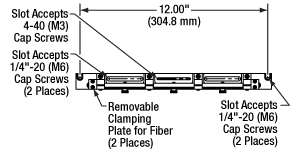
Click to Enlarge
Polarization Controller Mounting Features
- 3 Paddles Provide 3 Independently Rotatable Wave Plates
- Ø2.2" (56 mm) Fiber Loops
- Each Paddle Provides ±117.5° of Rotation
- Available Empty or Preloaded With FC/PC- or FC/APC-Terminated Fiber
- Replacement Ø900 µm Jacketed FC/PC or FC/APC Patch Cables Available
Thorlabs' 3-Paddle Fiber Polarization Controllers use stress-induced birefringence to create independent wave plates to alter the polarization of the transmitted light in single mode fiber. The three fractional wave plates are created by looping the fiber around three independent spools (see the Operation tab for details). For the polarization controllers preloaded with fiber, the three paddles are configured to approximate a quarter-wave, half-wave, and quarter-wave plate, in that order, when used at the design wavelength (see the table below).
The FPC560 fiber polarization controller is empty, allowing customers to insert single mode fiber with a Ø900 µm jacket. Additionally, we have Ø900 µm jacketed FC/PC and FC/APC patch cables available from stock that are suitable for use with these controllers. The other four controllers come preloaded with fiber. The fibers in the preloaded controllers can also be removed and replaced by the user in the event that the controllers are needed for a new application in the future. To ensure proper usage of the controllers, fiber cables must be long enough to achieve the recommended number of loops; see the Operation tab for more details.
The fiber is secured around three spools and by a clamp at each end of the controller. The spool covers have knobs for easy loading and unloading and the clamps are held in place by 4-40 screws. If needed, the top of the clamps can be completely removed to load terminated fibers. To secure the controller to the optical table, two clearance slots for 1/4"-20 (M6) cap screws are positioned 12.00" (304.8 mm) apart on the base plate. All 3-paddle controllers have three additional long slots along their base for more mounting options to both metric and imperial optical tables. Two slots at either end of the base accept 1/4"-20 (M6) cap screws (see the upper right image), while a centered slot accepts 4-40 (M3) cap screws. A schematic of the mounting features described is shown to the right.
| Item #a | Wavelength Rangeb |
Design Wavelengthc |
Fiber | Included Patch Cabled |
Fiber Lead Lengthe |
Connectorsf | Loop Diameter |
|---|---|---|---|---|---|---|---|
| FPC560 | N/A | N/A | N/A | N/A | N/A | N/A | 2.2" (56 mm) |
| FPC563 | 780 - 970 nm | 780 nm and 850 nm | 780HP | P3-780Y-FC-5 | 180 cm | FC/APC | |
| FPC564 | 980 - 1650 nm | 980 nm and 1064 nm | HI1060-J9 | P3-1064Y-FC-5 | FC/APC | ||
| FPC561 | 1260 - 1625 nm | 1310 nm and 1550 nm | SMF-28-J9 | P1-SMF28Y-FC-5 | 145 cm | FC/PC | |
| FPC562 | P3-SMF28Y-FC-5 | FC/APC |


Click Here to Enlarge
A 3-paddle controller mounted on an optical table utilizing the 1/4"-20 (M6) screw slots.
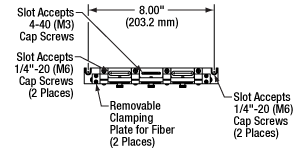
Click to Enlarge
Polarization Controller Mounting Features
- 3 Paddles Provide 3 Independently Rotatable Wave Plates
- Ø1.06" (27 mm) Fiber Loops
- Each Paddle Provides ±117.5° of Rotation
- Available Empty or Preloaded With FC/PC- or FC/APC-Terminated Fiber
- Replacement Ø900 µm Jacketed FC/PC or FC/APC Patch Cables Available
Thorlabs' 3-Paddle Fiber Polarization Controllers use stress-induced birefringence to create independent wave plates to alter the polarization of the transmitted light in single mode fiber. The three fractional wave plates are created by looping the fiber around three independent spools (see the Operation tab for details). For the polarization controllers preloaded with fiber, the three paddles are configured to approximate a quarter-wave, half-wave, and quarter-wave plate, in that order, when used at the design wavelength (see the table below).
The FPC030 fiber polarization controller is empty, allowing customers to insert a single mode fiber with a Ø900 µm jacket. Additionally, we have Ø900 µm jacketed FC/PC and FC/APC patch cables available from stock that are suitable for use with these controllers. The other four controllers come preloaded with fiber. The fibers in the preloaded controllers can also be removed and replaced by the user in the event that the controllers are needed for a new application in the future. To ensure proper usage of the controllers, fiber cables must be long enough to achieve the recommended number of loops; see the Operation tab for more details. For fibers with higher bend loss, we recommend using our Ø56 mm polarization controllers, thereby causing the least amount of bending.
The fiber is secured around three spools and by a clamp at each end of the controller. The spool covers have knobs for easy loading and unloading and the clamps are held in place by 4-40 screws. If needed, the top of the clamps can be completely removed to load terminated fibers. To secure the controller to the optical table, two clearance slots for 1/4"-20 (M6) cap screws are positioned 8.00" (203.2 mm) apart on the base plate. All 3-paddle controllers have three additional long slots along their base for more mounting options to both metric and imperial optical tables. Two slots at either end of the base accept 1/4"-20 (M6) cap screws (see the upper right image), while a centered slot accepts 4-40 (M3) cap screws. A schematic of the mounting features described is shown to the right.
| Item #a | Wavelength Rangeb |
Design Wavelengthc |
Fiber | Included Patch Cabled |
Fiber Lead Lengthe |
Connectorsf | Loop Diameter |
|---|---|---|---|---|---|---|---|
| FPC030 | N/A | N/A | N/A | N/A | N/A | N/A | 1.06" (27 mm) |
| FPC033 | 780 - 970 nm | 780 nm and 850 nm | 780HP | P3-780Y-FC-2 | 83 cm | FC/APC | |
| FPC034 | 980 - 1650 nm | 980 nm and 1064 nm | HI1060-J9 | P3-1064Y-FC-2 | 66 cm | FC/APC | |
| FPC031 | 1260 - 1625 nm | 1310 nm and 1550 nm | CCC1310-J9 | -g | 70 cm | FC/PC | |
| FPC032 | FC/APC |

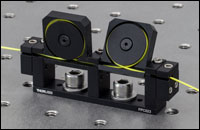
Click to Enlarge
2-Paddle Controller Mounted on an Optical Table
- 2 Paddles Provide 2 Independently Rotatable Wave Plates
- Ø0.71" (18 mm) Fiber Loops
- Each Paddle Provides ±143° of Rotation
- Available Empty or Preloaded With FC/APC-Terminated Fiber
- Replacement Ø900 µm Jacketed FC/PC or FC/APC Patch Cables Available
Thorlabs' Miniature 2-Paddle Fiber Polarization Controllers use stress-induced birefringence to create two independent wave plates to alter the polarization of the transmitted light in single mode fiber. The two fractional wave plates are created by looping the fiber around two independent spools (see the Operation tab for details). For the polarization controllers preloaded with fiber, the paddles are configured to approximate a quarter-wave plate and a half-wave plate when used at the design wavelength (see the table below).
The FPC020 polarization controller is empty, allowing customers to insert a single mode fiber with a Ø900 µm jacket. Additionally, we have Ø900 µm jacketed FC/PC and FC/APC patch cables available from stock that are suitable for use with these controllers. The other four controllers come preloaded with fiber. The fibers in the preloaded controllers can also be removed and replaced by the user in the event that the controllers are needed for a new application in the future. To ensure proper usage of the controllers, fiber cables must be long enough to achieve the recommended number of loops; see the Operation tab for more details. To ensure proper usage of the controllers, fiber cables must be long enough to achieve the recommended number of loops; see the Operation tab for more details.
The fiber is secured around two removable spools with a lip and two clamps at the ends of the controller. The clamps and spools are held in place by 4-40 cap screws, compatible with an 3/32" hex key or balldriver. Two clearance slots for 1/4"-20 or M6 cap screws are positioned 1" (25.4 mm) apart on the base for mounting the controller to an optical table (see the upper right image).
| Item #a | Wavelength Rangeb |
Design Wavelengthc |
Fiber | Included Patch Cabled |
Fiber Lead Lengthe |
Connectorsf | Loop Diameter |
|---|---|---|---|---|---|---|---|
| FPC020 | N/A | N/A | N/A | N/A | N/A | N/A | 0.71" (18 mm) |
| FPC021 | 488 - 633 nm | 488 nm | SM450 | P3-460Y-FC-2 | 83 cm | FC/APC | |
| FPC022 | 633 - 780 nm | 633 nm | SM600 | P3-630Y-FC-2 | 85 cm | ||
| FPC023 | 780 - 970 nm | 780 nm and 850 nm | 780HP | P3-780Y-FC-2 | 88 cm | ||
| FPC024 | 980 - 1650 nm | 980 nm | HI1060-J9 | P3-1064Y-FC-2 | 80 cm | ||
| FPC025 | 1260 - 1625 nm | 1310 nm | CCC1310-J9 | -g | 83 cm |
 Products Home
Products Home















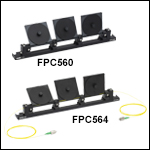
 Zoom
Zoom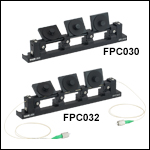
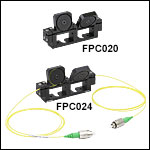
 2- and 3-Paddle Polarization Controllers
2- and 3-Paddle Polarization Controllers